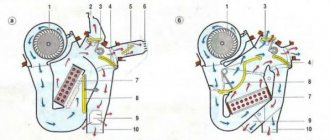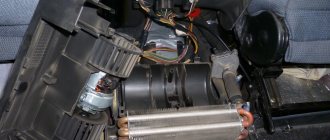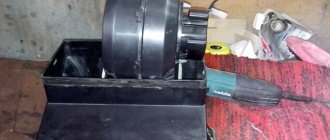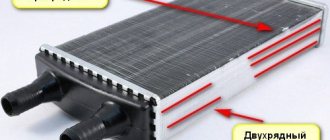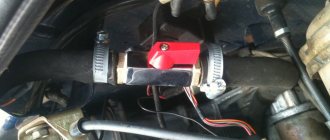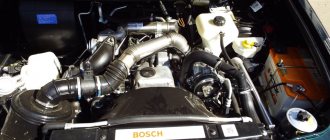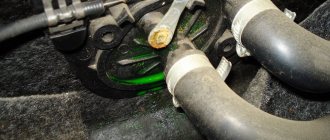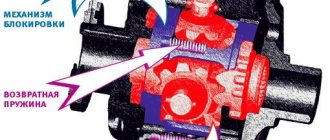Replacing the UAZ heater radiator
The interior heating system of SUVs from the Ulyanovsk Automobile Plant is structurally quite simple and does not differ from that of most modern cars. The heater itself, which even in specialized literature is often called a stove, consists of a box in which there is a radiator, a fan with an electric motor and an additional resistance designed to control the engine rotation speed. The heater is most directly involved in the operation of the car's cooling system, being its component.
Design features of the UAZ heater
The ventilation system, which forms an integral whole with the heating system, consists of an air intake, dampers of the heat exchanger box, as well as two corrugated hoses leading to the windshield blower nozzles.
Since 2010, changes have been made to the design of the UAZ heater to prevent moisture from entering the box. To do this, an additional box is installed between the air intake flap and the stove radiator, designed to collect and subsequently drain rainwater, penetrating into the air intake of the car when the flap is open. As the tank fills, excess water is discharged out through a drain hose leading to a partition separating the interior from the engine compartment.
Unfortunately, the installation of this plastic tank (catalog number - 3151-08101231) worsened the throughput of the car's natural ventilation system when driving, especially at low speeds, which especially affects the hot season, forcing the use of forced ventilation. But there is also a positive point - raindrops do not have the opportunity to fall on the walls of the hot heat exchanger to form steam, which then follows with the air flow into the cabin and condenses on the glass. In addition, the tank also protects against other pollutants, including dust, sand, plant branches and insects.
Natural ventilation of the car involves blowing the interior through the vents of the side windows, as well as through the external air intakes (grilles located directly on the hood in front of the windshield). Forced ventilation involves forcing air into the cabin using an electric fan installed in the stove box. In this case, the air flow can be directed into the deflectors either heated (with the radiator tap open) or cold.
In addition to blowing the windshield, air flows to the leg area of those sitting in front (driver and passenger), and in some models to the rear seats through air ducts laid in the central tunnel.
The level of airflow in the cabin is adjusted by a regulator that switches the operating modes of the electric fan, as well as a regulator that opens the air intake flap to a certain amount.
As practice shows, the intensity of airflow into the UAZ interior with the windows completely closed is insufficient both in the summer and in winter. Therefore, most SUV owners are looking for ways to eliminate this design flaw, one of which is replacing the standard heat exchanger with a more spacious one while simultaneously replacing the fan motor.
Malfunctions of the UAZ heater tap
Being a mechanical device, it is in semi-permanent contact with an aggressive environment (antifreeze is not water, it also contains alcohols and some other additives). This means that over time, this part of the UAZ climate system may fail, which will cause a lack of heat in the cabin (which is very fraught in winter) or, conversely, as a result of such a breakdown, coolant will constantly circulate in the radiator. This is bad in the summer, and in general worse, since it creates additional load on both the stove radiator and the pump.
Let's consider the main malfunctions of the faucet that affect its functionality:
- oxidation due to contact of liquid with metal;
- violation of integrity as a result of corrosion processes;
- jamming of the rotary valve, which is usually also a consequence of rust accumulation inside the faucet;
- breakdown of the coupling mechanism between the faucet and the regulator.
It is very rare to encounter such a nuisance as a broken heater tap. This usually happens when repair work is being carried out on a UAZ - the faucet may be installed crookedly, and when trying to open/close it simply breaks.
How does the UAZ stove work?
The air entering the car interior is heated in the radiator of the UAZ heater, and the amount of coolant circulating in the heat exchanger is adjusted using a tap. On some UAZ models (in particular, those equipped with the UMZ-417/421 power unit), this tap is located on the engine itself (in the area of the BC head), which limits the ability to regulate the amount of heat entering the interior of the SUV. On models with a ZMZ-409 engine, the heater switch is located on the dashboard on the passenger side.
On the latest versions of UAZ with the ZMZ-409 engine, it is possible to install a remote control system for the position of the faucet, which significantly simplifies the control of the operation of the stove.
When the tap is open, the antifreeze circulating in the cooling system line enters the radiator directly from the cylinder block of the power unit, that is, almost in the hottest phase. After the heat exchanger, the coolant is sent to the pump, forming a small circulation circuit that operates parallel to the main or large circuit. The outside air entering through the open air intake hatch is directed into the stove body, where a fan is turned on, forcing a flow of air onto the hot radiator. When heated, it follows the air duct system into the cabin. It is possible to distribute the flow of heated air in several directions: to the driver’s/front passenger’s feet, to the front windows, to the rear of the cabin (to the foot area). The UAZ does not provide airflow for the side windows, which can also be called a design flaw.
The operating mode switch for the electric fan motor has three positions: off, minimum and maximum engine speed. In addition to the blowing speed, it is possible to adjust the amount of air entering the cabin. The air intake flap opening regulator is responsible for this.
The UAZ heater radiator itself operates with maximum efficiency only when the engine is fully warmed up, that is, at a coolant temperature of 80°C and above. In winter, when the temperature drops to minus 20 degrees and below, in order to maintain the efficiency of the stove, it is advisable to take measures to preserve heat by covering the main radiator with a special insulating cover. On UAZ 31512/31514/31519 models it is possible to adjust the degree of opening of the radiator grille shutters.
Additional stove
In winter, UAZ Patriot models have the problem of heating the interior with one stove, so craftsmen install an additional one with their own hands. An additional hose outlet is made from the radiator to the second stove. When installing a second heater, the cabin becomes significantly warmer even at the first air supply speed.
On the radiator, when installing a second heater, liquid is not pumped from the bottom up as at the factory, but on the contrary, there is no need to install a pump for air circulation. The additional stove is installed in the armrest, there is just enough space there, there is no need to cut anything additional.
We connect our own switch to the second stove to turn it on additionally. After installing the second stove, the heating system works much better on the UAZ Patriot.
Main malfunctions of the UAZ stove
If in the warm season we simply forget about the presence of a cabin heater, then as cold weather approaches, owners of domestic SUVs have to remember that the efficiency of the stove does not always correspond to weather conditions.
So, what is a radiator - the main part of the stove? This is a metal box, inside of which there is an extensive network of plates, or honeycombs, made of aluminum. By circulating between these plates, the antifreeze cools, transferring heat to the radiator honeycombs. The air passing between them heats up and flows into the cabin. This rather primitive, but quite effective scheme is used on most modern cars.
In this case, a fan is necessary - without it, the air will heat up, but will flow into the air ducts by gravity, that is, at a minimum speed. Thus, the radiator is directly responsible for heating the air coming from outside (no wonder its second name is heat exchanger), and the fan is a means of delivering hot air inside the car.
On average, the service life of a stove radiator is decent - about 100 thousand kilometers, but this indicator is influenced by many diverse factors. If the car is used little in the winter, and the operating conditions are good (driving on roads of acceptable quality, living in an ecologically clean region), then the heater will not bother the car owner even after driving 200 thousand kilometers. But much more often, the exact opposite situations occur, when in winter you have to travel often, the roads are bad, and the environment is terrible. And if you use low-quality antifreeze, and even more so if you fill it with ordinary water instead of antifreeze in the summer, this will lead to clogging of the radiator honeycombs, which will affect the reduction of its heat transfer to an unacceptable level. And this will happen much earlier than the statistical average.
It is not difficult to determine that the radiator is heavily clogged: firstly, you will notice this by a decrease in the temperature in the cabin, all other things being equal (stove operating mode, outside air temperature). Secondly, one of the most characteristic signs of problems with the heater radiator is frequent fogging of car windows, and for quite a long time. Finally, if unpleasant odors appear in the cabin, we can assume that their source is a completely clogged heat exchanger honeycomb, which creates ideal conditions for the decomposition of organic debris accumulated on the walls of the radiator.
The way to eliminate the problem is to flush or replace the heater radiator of the UAZ Farmer, if the flushing procedures are unsuccessful.
The second common stove malfunction is a radiator leak. It is revealed by the appearance of a characteristic sickly-sweet smell in the cabin - the result of coolant vapors entering the cabin. In such cases, it is necessary to immediately begin searching for the leak and eliminating it.
If a leak has formed in the faucet, it must be replaced.
It is much worse if antifreeze leaks directly from the radiator. This often happens on aged heat exchangers due to the appearance of microcracks, which over time, under the influence of unfavorable factors (aggressive environment plus high temperatures), expand until they lose their tightness. Although aluminum is considered a non-corrosive metal, it also oxidizes, albeit at a noticeably lower rate and intensity. So pockets of corrosion can also cause radiator leaks, as well as external mechanical influences (the consequences of car impacts or the result of previously carried out repair work).
Replacing the UAZ Hunter heater radiator
The interior heating system of SUVs from the Ulyanovsk Automobile Plant is structurally quite simple and does not differ from that of most modern cars. The heater itself, which even in specialized literature is often called a stove, consists of a box in which there is a radiator, a fan with an electric motor and an additional resistance designed to control the engine rotation speed. The heater is most directly involved in the operation of the car's cooling system, being its component.
Design features of the UAZ heater
The ventilation system, which forms an integral whole with the heating system, consists of an air intake, dampers of the heat exchanger box, as well as two corrugated hoses leading to the windshield blower nozzles.
Since 2010, changes have been made to the design of the UAZ heater to prevent moisture from entering the box. To do this, an additional box is installed between the air intake flap and the stove radiator, designed to collect and subsequently drain rainwater, penetrating into the air intake of the car when the flap is open. As the tank fills, excess water is discharged out through a drain hose leading to a partition separating the interior from the engine compartment.
Unfortunately, the installation of this plastic tank (catalog number - 3151-08101231) worsened the throughput of the car's natural ventilation system when driving, especially at low speeds, which especially affects the hot season, forcing the use of forced ventilation. But there is also a positive point - raindrops do not have the opportunity to fall on the walls of the hot heat exchanger to form steam, which then follows with the air flow into the cabin and condenses on the glass. In addition, the tank also protects against other pollutants, including dust, sand, plant branches and insects.
Natural ventilation of the car involves blowing the interior through the vents of the side windows, as well as through the external air intakes (grilles located directly on the hood in front of the windshield). Forced ventilation involves forcing air into the cabin using an electric fan installed in the stove box. In this case, the air flow can be directed into the deflectors either heated (with the radiator tap open) or cold.
In addition to blowing the windshield, air flows to the leg area of those sitting in front (driver and passenger), and in some models to the rear seats through air ducts laid in the central tunnel.
The level of airflow in the cabin is adjusted by a regulator that switches the operating modes of the electric fan, as well as a regulator that opens the air intake flap to a certain amount.
As practice shows, the intensity of airflow into the UAZ interior with the windows completely closed is insufficient both in the summer and in winter. Therefore, most SUV owners are looking for ways to eliminate this design flaw, one of which is replacing the standard heat exchanger with a more spacious one while simultaneously replacing the fan motor.
How does the UAZ stove work?
The air entering the car interior is heated in the radiator of the UAZ heater, and the amount of coolant circulating in the heat exchanger is adjusted using a tap. On some UAZ models (in particular, those equipped with the UMZ-417/421 power unit), this tap is located on the engine itself (in the area of the BC head), which limits the ability to regulate the amount of heat entering the interior of the SUV. On models with a ZMZ-409 engine, the heater switch is located on the dashboard on the passenger side.
On the latest versions of UAZ with the ZMZ-409 engine, it is possible to install a remote control system for the position of the faucet, which significantly simplifies the control of the operation of the stove.
When the tap is open, the antifreeze circulating in the cooling system line enters the radiator directly from the cylinder block of the power unit, that is, almost in the hottest phase. After the heat exchanger, the coolant is sent to the pump, forming a small circulation circuit that operates parallel to the main or large circuit.
The outside air entering through the open air intake hatch is directed into the stove body, where a fan is turned on, forcing a flow of air onto the hot radiator. When heated, it follows the air duct system into the cabin. It is possible to distribute the flow of heated air in several directions: to the driver’s/front passenger’s feet, to the front windows, to the rear of the cabin (to the foot area).
The UAZ does not provide airflow for the side windows, which can also be called a design flaw.
The operating mode switch for the electric fan motor has three positions: off, minimum and maximum engine speed. In addition to the blowing speed, it is possible to adjust the amount of air entering the cabin. The air intake flap opening regulator is responsible for this.
The UAZ heater radiator itself operates with maximum efficiency only when the engine is fully warmed up, that is, at a coolant temperature of 80°C and above. In winter, when the temperature drops to minus 20 degrees and below, in order to maintain the efficiency of the stove, it is advisable to take measures to preserve heat by covering the main radiator with a special insulating cover. On UAZ 31512/31514/31519 models it is possible to adjust the degree of opening of the radiator grille shutters.
Main malfunctions of the UAZ stove
If in the warm season we simply forget about the presence of a cabin heater, then as cold weather approaches, owners of domestic SUVs have to remember that the efficiency of the stove does not always correspond to weather conditions.
So, what is a radiator - the main part of the stove? This is a metal box, inside of which there is an extensive network of plates, or honeycombs, made of aluminum. By circulating between these plates, the antifreeze cools, transferring heat to the radiator honeycombs. The air passing between them heats up and flows into the cabin. This rather primitive, but quite effective scheme is used on most modern cars.
In this case, a fan is necessary - without it, the air will heat up, but will flow into the air ducts by gravity, that is, at a minimum speed. Thus, the radiator is directly responsible for heating the air coming from outside (no wonder its second name is heat exchanger), and the fan is a means of delivering hot air inside the car.
On average, the service life of a stove radiator is decent - about 100 thousand kilometers, but this indicator is influenced by many diverse factors. If the car is used little in the winter, and the operating conditions are good (driving on roads of acceptable quality, living in an ecologically clean region), then the heater will not bother the car owner even after driving 200 thousand kilometers.
But much more often, the exact opposite situations occur, when in winter you have to travel often, the roads are bad, and the environment is terrible. And if you use low-quality antifreeze, and even more so if you fill it with ordinary water instead of antifreeze in the summer, this will lead to clogging of the radiator honeycombs, which will affect the reduction of its heat transfer to an unacceptable level. And this will happen much earlier than the statistical average.
It is not difficult to determine that the radiator is heavily clogged: firstly, you will notice this by a decrease in the temperature in the cabin, all other things being equal (stove operating mode, outside air temperature). Secondly, one of the most characteristic signs of problems with the heater radiator is frequent fogging of car windows, and for quite a long time. Finally, if unpleasant odors appear in the cabin, we can assume that their source is a completely clogged heat exchanger honeycomb, which creates ideal conditions for the decomposition of organic debris accumulated on the walls of the radiator.
The way to eliminate the problem is to flush or replace the heater radiator of the UAZ Farmer, if the flushing procedures are unsuccessful.
The second common stove malfunction is a radiator leak. It is revealed by the appearance of a characteristic sickly-sweet smell in the cabin - the result of coolant vapors entering the cabin. In such cases, it is necessary to immediately begin searching for the leak and eliminating it.
If a leak has formed in the faucet, it must be replaced.
It is much worse if antifreeze leaks directly from the radiator. This often happens on aged heat exchangers due to the appearance of microcracks, which over time, under the influence of unfavorable factors (aggressive environment plus high temperatures), expand until they lose their tightness. Although aluminum is considered a non-corrosive metal, it also oxidizes, albeit at a noticeably lower rate and intensity. So pockets of corrosion can also cause radiator leaks, as well as external mechanical influences (the consequences of car impacts or the result of previously carried out repair work).
A coolant leak is fraught not only with a deterioration in the operation of the stove, but also with engine overheating due to a lack of coolant, and this is a malfunction that is more serious in its consequences. The bad thing is that if the leak is weak, it is very difficult to notice it in time. That is why it is recommended to always pay attention to the expansion tank when checking the engine oil level.
Source: https://nadouchest.ru/zamena-radiatora-pechki-uaz-hanter/
Radiator replacement algorithm
Let us consider in detail how to remove the heater radiator of UAZ family vehicles using the example of the Patriot model. This procedure is not too complicated from a technical point of view, but it requires a significant amount of time. We will need a minimum set of tools (screwdrivers, hammer, wrenches, rags and a container for draining antifreeze).
So, let's start dismantling the stove radiator:
- de-energize the car by removing the negative terminal of the battery;
- We drain the coolant from the main radiator tap. The approximate volume of leaked antifreeze is 10 liters, although the filling volume is 12 liters (some of the liquid will remain in the system, and in its different components);
- We dismantle the dashboard;
- we start by removing the heater control handles (they are secured with screws located at the bottom of the handles);
- dismantle the lining of the stove control panel;
- take out the ashtray and the compartment for storing small items;
- unscrew three screws on each side;
- dismantle both glove boxes (they are secured with screws located inside), and then unscrew the fasteners of the additional glove compartment shelf. When removing the drawers, do not forget to disconnect the backlight connectors;
- to remove the dashboard, you need to unscrew two nuts, accessed through the panel openings, as well as the side nuts, removing the side decorative panels (they are secured with clips);
- unscrew the bolts attaching the panel to the support frame bracket;
- remove the panel along with the air ducts;
- Having gained access to the heater unit, disconnect the power connectors of the electric fan;
- disconnect the air ducts going to the radiator (unscrew three screws) in the area where the air flow exits the stove body;
- unscrew the two self-tapping screws fastening to the air intake stove;
- All that remains is to unscrew the nut securing the heater frame to the front panel;
- take out the air duct;
- unscrew the screws that secure the decorative trim of the heater;
- loosen the clamps securing the inlet and outlet pipes of the stove radiator, disconnect the pipes (since, as we have already said, some of the antifreeze remains in the line, when disconnecting the hoses, a certain amount of coolant will spill, so as not to lose it, we substitute containers of suitable sizes);
- remove the heater from its seat.
Now you can begin to inspect the radiator in order to repair or flush it. If its condition is such that repair procedures are impractical, we buy a new heat exchanger.
Installation is in the reverse order.
As you can see, in order to remove the UAZ heater core, you will have to disassemble the dashboard, and this is the most time-consuming part of the work. If you want to install an analogue instead of the original heat exchanger, get ready for the fact that you will have to make minor modifications - you will not find radiators that are exactly compatible with the standard ones.
How to remove the UAZ Hunter stove
It all started with the purchase of a car. After driving the car home, I noticed small drops on the passenger floor mat. I tightened the clamps on the stove tap and it seemed to help, but not for long. Gradually, the drops on the rug smoothly grew into small wet spots, and in the end, after arriving from a business trip in the morning, I found THIS on the rug!
What a surprise
I arrived at my father’s garage and the debriefing began. At first I thought that the radiator on the stove was leaking, but after analysis it turned out everything was fine.
Here's a radiator, it's a radiator, it's hard to freeze
After checking the supplies, my father found a completely new motor for the stove, according to him, from the LIAZ bus on which he worked 15 years ago, because... In terms of power it was higher, it was decided to install it.
Original motor 12/25
new 12/60. It's like it came straight from the assembly line. and you can’t tell that he’s already 15 years old
We collected everything into our own building,
original stove body
replacing the pipes
The pipes for the heater faucet (by the way, the faucet is the same as the VAZ)
Everything was installed back on the radiator. The stove started working like a helicopter. The revs were blown away (but the problem of the windshield fogging never went away), and the leak did not go away. I finally started to blame the radiator - what if it wasn’t sealed after all. They didn’t immediately disassemble it in a new way, because... in a week the NAMI-4 stove ordered earlier was supposed to be delivered. And she is in my hands.
dear and so long-awaited
We quickly took off the old stove.
The second time we filmed it took about 10 minutes
As per the instructions for dismantling the floor, the design of the air flow into the cabin.
extra spare parts on the shelf (maybe they will fit somewhere else)
there are no extra spare parts in the garage
We will find application in another project.
Putting the new stove in place
There will be more room at the passenger's feet!
We connect the air ducts and pipes to the faucet (by the way, the hoses that were included with the stove did not fit at all; we had to make them with adapters from what we had.
it turned out not bad enough
put it in place and connect the air control panel and rheostat
It already looks much more solid in the cabin.
We attach the air filter and air intake to the outside.
A very decent element of the exterior
Let's try. The stove is just great. Having driven 150 km on the highway after installation and about 100 km in the city, I realized that how could I ever drive without it before. I put the cloth for wiping the glass further inside the cabin, I hope to forget about it for a long time. Thank you very much to the manufacturer. This is something without which it is impossible to move normally in intensive mode, especially during rain. By the way, about the main problem, which is why I started disassembling the stove! It turns out that the valve on the heater was leaking from under the valve closing/opening rod. This time I bought a collapsible one. I put it together with NAMI-4.
The main culprit for the start of all heater modifications.
How to remove the stove on a UAZ 469 with your own hands
To ensure that operating a car in the winter does not cause discomfort, first of all, a working heater must be installed in the car. Car owners of domestic UAZ vehicles are often faced with the problem of the heater not working, resulting in the need to replace it. In this article we will tell you how to select a UAZ Bukhanka stove and how to replace this device with your own hands.
Possible faults
First, let's look at the main malfunctions of the heating system on the UAZ 469:
- The air ducts of the device are not sealed. Because of this, there is a possibility of heat loss, and accordingly, the UAZ stove will not blow enough.
- Antifreeze leak from the radiator unit. If a breakdown occurs in the design of the device, it will need to be replaced.
- The radiator assembly is clogged, causing air to not flow into the cabin. If possible, you can try to clean the stove radiator.
- Also, the problem of lack of air can occur if one of the air duct pipes is clogged. For example, the reason may be that leaves, grass and other debris get into the system.
- The heater valve is leaking. The problem is solved by replacing this element of the system.
- If the heater does not work at all, then the reason may lie in the failure of the electric motor or the burnout of the safety element responsible for its operation. If the electric motor or fuse breaks, these components must be replaced.
UAZ car interior
Criteria for choosing a stove radiator
To make the interior heater work more efficiently, you can replace it with a more powerful device. Alternatively, taxes from VAZ can be used for this purpose, but this option involves altering the structure, in particular, the crane. There is also an option to install an additional heater in the rear of the cabin, this will allow you to warm up the car more quickly and efficiently.
The choice of devices is not particularly large; when purchasing, you should be guided by your financial capabilities, as well as preferences:
- heating device KITB;
- stoves NAMI-4 or NAMI-7,
- AvtoVAZ radiator.
According to many experts, the best option would be to install a NAMI-4 stove on a UAZ running on gas. In this case, the power of the heating unit should be 2-4 kW. The main advantage of the NAMI stove is its autonomous support of the set temperature in the car interior . As for the disadvantages, it is the complexity of installation (the author of the video is the Difen Difen channel).
Instructions for replacing the stove
How to change the stove on a UAZ:
- First you need to drain the antifreeze from the system. To do this, you need to disconnect the coolant pipes connected to the heating unit, as well as the windshield blower pipes. Having done this, you will need to connect the wiring.
- Next, disconnect the console from the control panel. Dismantle the installed heating unit, the air intake hatch, the rubberized seal, and the hatch control device. Having done this, holes will appear in the air intake box itself; you will need to plug them. The groove where the hatch seal was located should be cleaned of the old seal and also degreased.
- Then try on the air filter housing to the air intake, then use a drill to drill 8 holes in the metal around the perimeter of the housing, the diameter of which should be 3.2 mm.
- Next, the filter element housing can be put aside. Remove the metal shavings, and a layer of sealant will need to be applied to the air intake installation site. Do not skimp on the sealant, because the larger the layer, the less likely it is that water will get into the interior. Having done this, install the housing and secure it with self-tapping screws; excess sealant must be removed.
- Reinstall the cabin filters.
- The next stage of work will be carried out in the salon. You need to install a new heater; two studs and M6 nuts are used to secure it. Having fixed the unit, you need to install the plastic console of the control unit. To do this, it is necessary to make appropriate holes in the console, taking into account the fact that the console should be located approximately in the same plane as the control panel. The control device console must be secured using self-tapping screws.
- Having completed these steps, you will need to connect the faucet control rod, and then secure it in place using the bracket that should be included in the kit. Connect the antifreeze pipes to the new heating unit, securing them securely with clamps. Also install windshield defogger ducts. The process of installing the pipes can cause difficulties, since they are initially included in the kit and are already bent. Apparently, Bukhanka's engineers tried to give them the shape in which they should be installed. However, during installation, the car owner will most likely encounter such a problem, so the pipes will have to be bent the way you need.
- The final step will be connecting the electrical part. The stove's power cable can be connected to a wire that is used to provide power to additional devices. The ground can be fixed on the breaker bolt.
- Now you only need to fill the consumables into the system and diagnose its performance. If everything works correctly, you can enjoy better and more efficient heater operation. If something goes wrong, then recheck the entire circuit.
How to remove the UAZ Hunter stove
05/23/2018 admin Comments No comments
It all started with the purchase of a car. After driving the car home, I noticed small drops on the passenger floor mat. I tightened the clamps on the stove tap and it seemed to help, but not for long. Gradually, the drops on the rug smoothly grew into small wet spots, and in the end, after arriving from a business trip in the morning, I found THIS on the rug!
What a surprise
I arrived at my father’s garage and the debriefing began. At first I thought that the radiator on the stove was leaking, but after analysis it turned out everything was fine.
Here's a radiator, it's a radiator, it's hard to freeze
After checking the supplies, my father found a completely new motor for the stove, according to him, from the LIAZ bus on which he worked 15 years ago, because... In terms of power it was higher, it was decided to install it.
How to remove the radiator of the UAZ 469 stove
To ensure that operating a car in the winter does not cause discomfort, first of all, a working heater must be installed in the car. Car owners of domestic UAZ vehicles are often faced with the problem of the heater not working, resulting in the need to replace it. In this article we will tell you how to select a UAZ Bukhanka stove and how to replace this device with your own hands.
Site about off-road vehicles, SUVs, off-road vehicles
The best improvement to the standard UAZ Hunter heater is its replacement with a more advanced and efficient heater produced by NAMI. It has more advantages than disadvantages, the main one of which is the high price. If you want to save money, then you can increase the efficiency of the standard heater with the help of some simple modifications, which will be discussed below.
Refinement and improvement of the UAZ Hunter heater design.
You should start by sealing the heater housing. To do this, it must be removed from the car and all corners and joints of the body parts must be sealed from the inside using automotive sealant. And then, preferably, also from the inside, cover the walls of the box with thin, 2-3 mm, sheets of automotive noise and vibration insulation. All this together will eliminate air leaks, slightly increase heat transfer and somewhat reduce the overall noise of the heater during operation of the electric motor.
The next step is to try using any available method, for example by gluing a window seal around the perimeter, to seal the lower rectangular outlet hatch of the heater housing. This is necessary in order to eliminate air leaks when the hatch cover is closed, thereby increasing the strength of the air flow that will flow through the corrugated hoses to the windshield or through the lower side air distributors.
Well, in conclusion, you need to remove or simply bend to the left the rectangular protrusion located from the inside of the heater housing and partially covering the left outlet pipe supplying air to the windshield. The general purpose and functionality of this protrusion in the design is not entirely clear, but the fact that without it the force of air supply into the left corrugated hose increases, and therefore the force of blowing the windshield on the driver’s side increases, is a fact.
Rain water leaking from the UAZ Hunter heater housing into the passenger compartment.
Despite the plastic box installed under the air intake hatch, some of the rainwater, when the hatch cover is closed, can still get into the UAZ Hunter’s interior when parked. Initially, as a result of inspection and control during the rain, it seemed that water droplets were entering the cabin somehow through the drain hose of the box.
It was then assumed that the plastic box itself was damaged. In fact, it was precisely determined that water enters the cabin through the joint of the upper internal iron heater box, which exits to the outside of the body. There it forms a small side on which the lower seal of the hatch is installed.
Rainwater flows under this seal, then goes into the gap between the protruding side of the box and the body itself. And from there it immediately gets inside the heater housing and then flows through leaks under the feet of the driver or front passenger. That is, it does not initially fall into the plastic box, but bypasses it.
Therefore, the lower rubber seal of the hatch must be removed, treated well with body sealant around the joining seam that has become visible, and then put the seal in place. No more water will flow into the cabin through the heater.
Installing a door seal on the air intake hatch cover of a UAZ Hunter.
In any case, whether a plastic box is installed on the car above the heater radiator or not, the natural entry of water and dust into the heater, and then into the passenger compartment when the air intake flap is closed, must be prevented. A plastic cover installed on top of the hatch will best cope with this task. You just need to find out in advance whether it is suitable for the UAZ Hunter with a lower windshield wiper arm or not.
If you don’t want to drill additional holes in the car body to install such an overlay, then there is a simpler and cheaper method. It consists of replacing the standard rubber seal on the air intake flap cover with a seal that is installed from the factory on the inner door opening of the UAZ Hunter, its catalog number is 3153-6107018 or 3153-6107019. But in fact, this is an ordinary door seal from VAZ 2101, 2102, 2103, 2104, 2105, 2106, 2107, which goes under the numbers 2101-6107018, 2101-6207024, 2101-6207025.
There are no particular difficulties when installing such a seal. The only thing you need to pay attention to is that during installation the cover is raised as high as possible, as far as its adjustment holes allow. Now, when closed, the air intake hatch cover is maximally sealed around the entire perimeter and water ingress into the interior is practically excluded, even during very heavy rain.
Selecting and replacing the electric heater motor of the UAZ Hunter.
As standard, the UAZ Hunter heater is equipped with an ME236 electric motor with a power of 25 Watts. Its capabilities are frankly not enough to properly draw air through the radiator. The low performance of the ME236 also greatly affects the quality of windshield blowing.
Finding a more powerful electric motor to replace the ME236 is not difficult. For example, these could be electric motors 19.3730, 191.3730, 192.3730 and 194.3730 with a power of 40 Watts, or 197.3730 with a power of 60 Watts, or 51.3730 and 511.3730 with a power of 90 Watts. The main thing is that the diameter of the output shaft of the electric motor is 8 mm, so that a standard impeller can be installed without modifications, and also that it has suitable studs or threaded holes on its body for mounting it in the heater.
In addition, it would not be superfluous to take into account the load that, during operation, this electric motor will create on the on-board network and, accordingly, the generator. Thus, the current consumption of the 90-watt electric motor 511.3730 is 15 Amperes, versus 5 Amperes for the standard ME236. Therefore, perhaps the golden mean would be to install an electric motor 197.3730 with a power of 60 Watts and a current consumption of 8 Amps.
Installation of an additional stove on UAZ 469
Since our winters in Siberia are not entirely humane, the decision was made to install a second stove in the car.
Having explored the Internet. Advice from experienced people, it was decided to install a stove under the rear seats (Chinese with 6 outlet diffusers, three-speed with two impellers). It was purchased: - furnace - 3000 rubles - hose for the cooling system reinforced 5 meters - 500 rubles - clamps for 32 - 10 pcs (about 150-250 rubles) - tube of sealant - 50 rubles. — metal water pipes 15 mm 5 pcs — 150 RUR. — Gazelle pump 18 mm — 950 rub. The installation took me about 10 hours since I did it alone, taking my time in places and thinking about how and where to implement it...
The stove was hooked up in series. Thus. that the supply goes to the upper pipe of the original stove, comes out of it and goes through a hose to the stove at the back, after which it returns to the lower pipe of the faucet. I placed the gazelle pump on the lower branch pipe of the valve in the engine compartment and secured it to the battery frame.
the result is wonderful. You can ride in a car wearing a T-shirt...
PS. If anyone is interested I can post pictures...
The stove was stuck between the front seats. The holes in the floor for seat belts are ideal for mounting. For the third mounting point of the stove, I drilled a small hole in the casing above the transfer case and screwed it on with a self-tapping screw. The hoses and wires were pulled together with tape clamps and secured to the casing in several places. By passing the switch between the lever. speeds and transfer case levers. In short, right above the casing bolts in the center. I connected the wires to the standard stove. I decided not to bother with a separate switch. I drained the antifreeze only from the engine and not much, about two liters. The hoses were connected as follows: from the block head to the lower pipe of the radiator of the standard stove, from the upper pipe of the standard stove to the lower pipe of the additional one and, accordingly, from the upper pipe of the additional one to the pump. IF YOU CONNECT OTHERWISE IT WILL NOT WORK. Either the pump is not enough to pump this circuit or the radiators are only half heated. There is a positive effect from the additional heater: rear passengers feel much warmer and the interior warms up faster. Regards, Yuri
>=====In my mind, it was necessary to buy an additional auxiliary pump/pump for forced pumping of antifreeze. This pump/pump is installed on all minibuses of the Gazelle/Sobol family, if I’m not mistaken, in front of the heater tap and is powered by a separate button. >Sincerely, >Denis. > >
If your hands are crooked, the service life of this device is 15 minutes - close the stove tap and turn on the back one (on the trestle), after 15 minutes the pump is fried. But you don’t need to do that. The stoves should be parallel, with a separate (preferably, um, pneumatic or something else) valve on the back. Mine is exactly like this (I had to make tees, of course - I bought standard plumbing pieces of iron at the market and screwed them together), and nothing is covered. The effect is Tashkent in nature, the dog walker (there are 10 cubic meters!) warms up to +25 at -20 outside.
additional wires and a place where antifreeze can run onto the asphalt. This is not acceptable on an SUV.
Come on, it's not that scary. There are only one wires, zero spaces (you need to install normal clamps.).
If connected correctly, the pump pressure is enough to pump both stoves without an additional pump.
Not on xx. When driving - that's enough, when stopping - all the greedy goat-lovers who have fried the pump stand and fight with the toad. but the toad, of course, still wins.
powered by a separate key.
According to the standard, the pump is turned on together with the rear (interior) heater. I installed a separate switch for myself so that in the summer I could turn on the stove fan but not its heating and the pump.
The best improvement to the standard UAZ Hunter heater is its replacement with a more advanced and efficient heater produced by NAMI. It has more advantages than disadvantages, the main one of which is the high price. If you want to save money, then you can increase the efficiency of the standard heater with the help of some simple modifications, which will be discussed below.
Refinement and improvement of the UAZ Hunter heater design.
You should start by sealing the heater housing. To do this, it must be removed from the car and all corners and joints of the body parts must be sealed from the inside using automotive sealant. And then, preferably, also from the inside, cover the walls of the box with thin, 2-3 mm, sheets of automotive noise and vibration insulation. All this together will eliminate air leaks, slightly increase heat transfer and somewhat reduce the overall noise of the heater during operation of the electric motor.
The next step is to try using any available method, for example by gluing a window seal around the perimeter, to seal the lower rectangular outlet hatch of the heater housing. This is necessary in order to eliminate air leaks when the hatch cover is closed, thereby increasing the strength of the air flow that will flow through the corrugated hoses to the windshield or through the lower side air distributors.
Well, in conclusion, you need to remove or simply bend to the left the rectangular protrusion located from the inside of the heater housing and partially covering the left outlet pipe supplying air to the windshield. The general purpose and functionality of this protrusion in the design is not entirely clear, but the fact that without it the force of air supply into the left corrugated hose increases, and therefore the force of blowing the windshield on the driver’s side increases, is a fact.
Rain water leaking from the UAZ Hunter heater housing into the passenger compartment.
Despite the plastic box installed under the air intake hatch, some of the rainwater, when the hatch cover is closed, can still get into the UAZ Hunter’s interior when parked. Initially, as a result of inspection and control during the rain, it seemed that water droplets were entering the cabin somehow through the drain hose of the box.
It was then assumed that the plastic box itself was damaged. In fact, it was precisely determined that water enters the cabin through the joint of the upper internal iron heater box, which exits to the outside of the body. There it forms a small side on which the lower seal of the hatch is installed.
Rainwater flows under this seal, then goes into the gap between the protruding side of the box and the body itself. And from there it immediately gets inside the heater housing and then flows through leaks under the feet of the driver or front passenger. That is, it does not initially fall into the plastic box, but bypasses it.
Therefore, the lower rubber seal of the hatch must be removed, treated well with body sealant around the joining seam that has become visible, and then put the seal in place. No more water will flow into the cabin through the heater.
Installing a door seal on the air intake hatch cover of a UAZ Hunter.
In any case, whether a plastic box is installed on the car above the heater radiator or not, the natural entry of water and dust into the heater, and then into the passenger compartment when the air intake flap is closed, must be prevented. A plastic cover installed on top of the hatch will best cope with this task. You just need to find out in advance whether it is suitable for the UAZ Hunter with a lower windshield wiper arm or not.
If you don’t want to drill additional holes in the car body to install such an overlay, then there is a simpler and cheaper method. It consists of replacing the standard rubber seal on the air intake flap cover with a seal that is installed from the factory on the inner door opening of the UAZ Hunter, its catalog number is 3153-6107018 or 3153-6107019. But in fact, this is an ordinary door seal from VAZ 2101, 2102, 2103, 2104, 2105, 2106, 2107, which goes under the numbers 2101-6107018, 2101-6207024, 2101-6207025.
There are no particular difficulties when installing such a seal. The only thing you need to pay attention to is that during installation the cover is raised as high as possible, as far as its adjustment holes allow. Now, when closed, the air intake hatch cover is maximally sealed around the entire perimeter and water ingress into the interior is practically excluded, even during very heavy rain.
Replacing the heater radiator on a UAZ Patriot with and without air conditioning
In warm weather, any car, including the UAZ Patriot, does not need a heater, except in cases where the engine is “about” to overheat, and it needs to be cooled somehow. But everything changes with the onset of cold weather and during a transition period, such as autumn, for example. In the fall, due to constant rain, the car windows begin to fog up, and in the winter you can’t go far without a properly working stove.
The heater in the UAZ Patriot functions due to the constant circulation of engine coolant. This principle undoubtedly increases the overall efficiency, since energy losses in the form of heat from the engine are used to heat the interior, although some part is still absorbed by the atmosphere, without bringing any benefit. However, for example, an electric heater in a car not only does not use heat from the engine, but also requires additional power.
Design
The UAZ Patriot uses a heater in the form of a radiator, but not the same as the main cooling radiator in front of the engine, but smaller. In the UAZ Patriot, the heater radiator is installed in front under the instrument panel (dashboard). Inside it there are numerous aluminum plates, near which hot antifreeze or antifreeze circulates. There is a fan above the radiator that blows air around it. Also, the design includes a special damper that regulates the ratio of hot and cold air supplied to the cabin.
There may be two heater radiators in the UAZ Patriot in some trim levels with air conditioning. Although, in most cases, the design provides only one radiator. The entire set of parts can last a long time, the Patriot can travel more than 100 thousand kilometers, and the heater will quietly perform its function. However, this is true under one condition - timely replacement of the coolant is necessary. Although a breakdown may not necessarily occur because of this, a defective product is no exception.
Heater fan
In stoves, the fan is replaced in rare cases, for example, if work occurs under increased load, or if moisture gets on the parts, and also when it is impossible to make repairs. Replacing it is not difficult; difficulty may arise when removing the front console. The heater fan is easy to check.
You need to bring the car and, by changing the position of the heater control knob, determine by the sound whether there is any extraneous noise or not.
If there is noise, we begin our check by removing the cabin filter, it is probably clogged. The cabin filter sometimes becomes bent and interferes with the operation of the fan. In this case, we simply replace the old one with a new one and we will have normal airflow again.
Fan replacement
Next, to get to the fan you need to remove the glove compartment. It can be removed very easily; just remove two fasteners from the bottom inside the glove compartment on each side and the glove compartment can be removed. After removing the glove compartment, we will immediately see the motor that turns the fan.
Well, to get to the motor you need to unscrew the plastic frame on which the glove compartment is attached. When cold weather sets in, the interior of the UAZ Patriot is not warm enough, let's look at what causes this.
Replacing the cabin filter
To eliminate this, we started by replacing the cabin filter. After replacing the filter, the air flow supplied into the cabin through the fan increased. But at a strong negative temperature, this was not enough. As we know, our UAZ Patriot constantly lacks air circulation; in order to eliminate this, we removed the membrane under the hood that was preventing the passage of air.
Replacing the thermostat
The next reason is that the thermostat sticks - this is a common problem in UAZ vehicles; when the car warms up for 10 minutes, the interior does not heat up. Accordingly, the thermostat needs to be changed and at the same time we flush the engine cooling system. Moreover, according to many experts, cars that come from the factory are filled with very low quality fluids. It is better to rinse with FELIX red liquid. It is inexpensive and pours directly into water. When going through all the procedures, we measure the temperature from the hot air deflector, or with a regular bath thermometer. The difference between the measurements before and after is 15 degrees.
The fan and motor of the UAZ Patriot heater change as follows:
- The console is removed;
- The fan is removed;
- The fan and motor are replaced together;
- Assembly.

